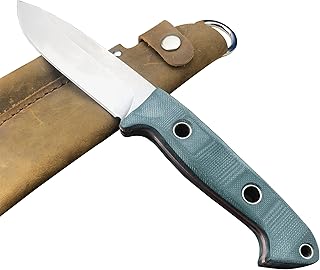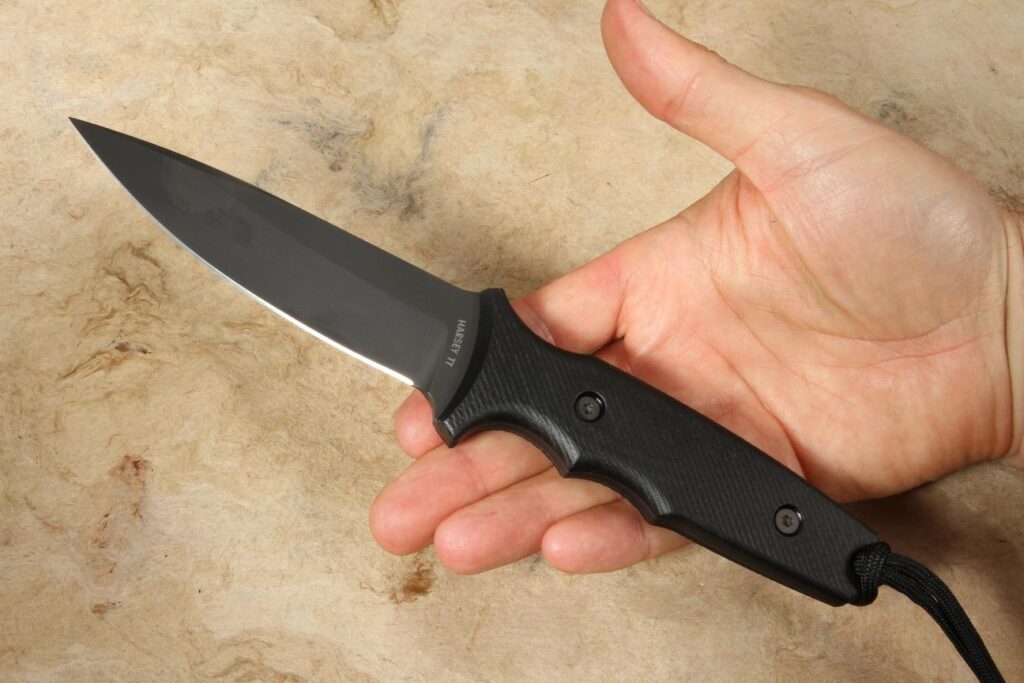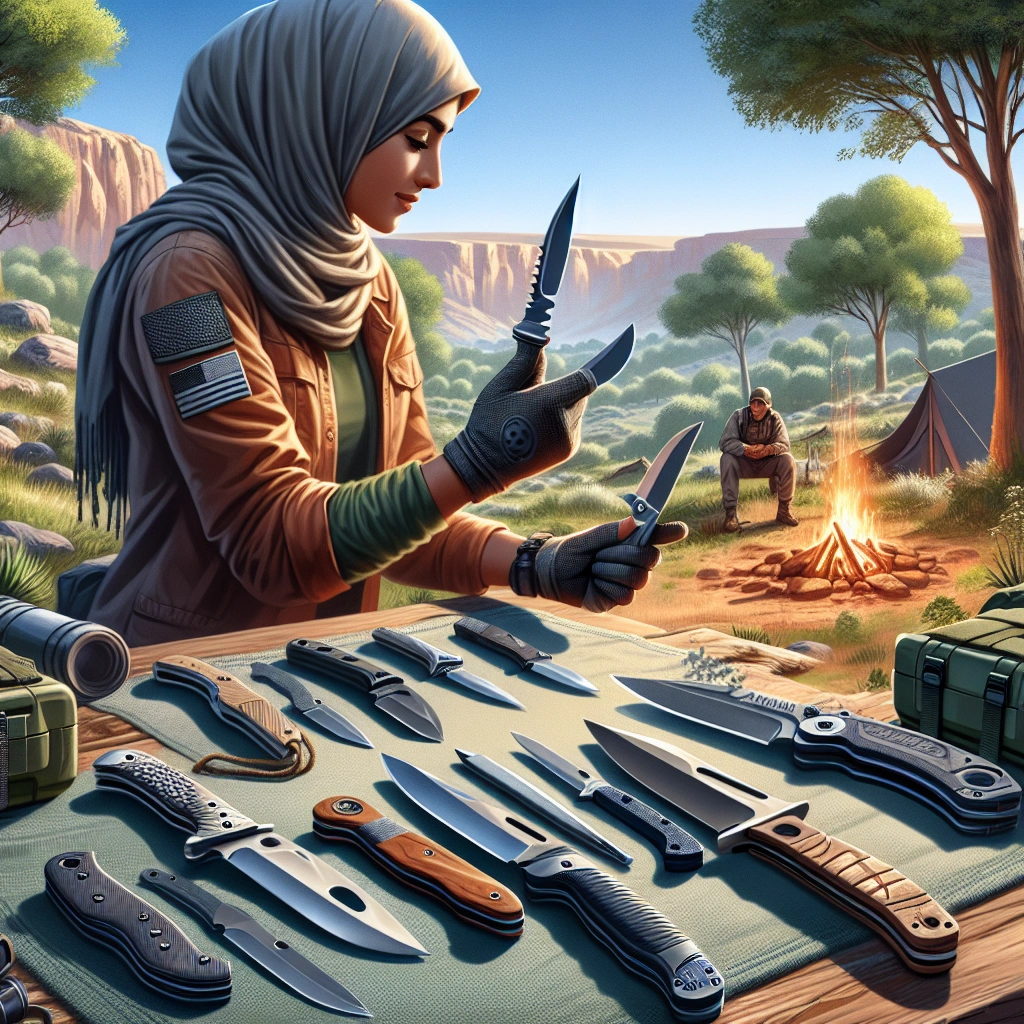

A bushcraft knife is a versatile tool used for various outdoor tasks such as cutting, carving, and crafting. It is an essential tool for survival and camping activities.
Choosing the right bushcraft knife is crucial for ensuring its durability, reliability, and functionality in various outdoor situations. It is important to consider the blade material, handle design, and overall construction of the knife when making a decision.
In this guide, we will provide Bushcraft Knife Reviews to help you find the best bushcraft knife for your needs, whether you are a beginner or an experienced outdoor enthusiast.
Check out this Youtube video: “BEST BUSHCRAFT KNIFE? Top 5 Best Bushcraft … – YouTube” to learn about the top bushcraft knives on the market and make an informed decision for your outdoor adventures.
Types of Bushcraft Knives
Multi-tool knives
| Knife Type | Advantages | Disadvantages |
|---|---|---|
| Fixed Blade | Versatile, durable, reliable | Limited portability, may be bulky |
| Folding | Compact, easy to carry, convenient | Potential mechanical failure, less robust |
| Multi-tool | Versatile, multiple functions | Limited robustness for heavy-duty tasks |
Factors to Consider When Choosing a Bushcraft Knife
Blade material
Carbon steel and stainless steel are the primary options for bushcraft knives. Carbon steel offers excellent edge retention and is easier to sharpen, but it’s prone to rust.
On the other hand, stainless steel is more resistant to corrosion, making it ideal for humid and wet environments.
Blade length
A bushcraft knife’s blade length typically ranges from 4 to 6 inches. A medium-sized knife, around 4.5 inches, is versatile for various survival tasks, except for heavy chopping due to its balance and weight.
Handle material
Titanium, Micarta, G-10, bone, wood, and metals like Titanium, Stainless Steel, and Aluminium are popular choices for bushcraft knife handles. Each material offers different levels of durability, grip, and aesthetics.
Tang type
Full tang knives, where the blade extends through the handle, provide better strength and durability, making them suitable for heavy-duty tasks in the wilderness. They are less likely to break under pressure compared to partial tang knives.
Sheath quality
A high-quality sheath is essential for safely carrying and accessing your bushcraft knife. Materials like Kydex and leather offer durability and protection against the elements, ensuring your knife is readily available when needed.
Top 5 Bushcraft Knives for 2023
Review of Bushcraft Knife A
The DAX Hunter Pro is a top contender for 2023, boasting a 4.5-inch full-tang blade of high-carbon stainless steel, ideal for tough outdoor tasks. Its ergonomic micarta handle provides a comfortable and secure grip, making it a reliable companion for bushcraft adventures.
Review of Bushcraft Knife B
The Gerber StrongArm stands out with its 4.8-inch 420HC blade and diamond-texture rubber handle, delivering a firm grip even in wet conditions. It’s designed for versatility, excelling in cutting, batoning, and detailed carving tasks in the wild.
Review of Bushcraft Knife C
The ESEE 4P offers rugged performance with its 4.5-inch 1095 carbon steel blade, designed for heavy-duty use in the wilderness. Its canvas micarta handle ensures a comfortable and secure hold, making it a dependable tool for survival scenarios.
Review of Bushcraft Knife D
The Fallkniven F1x impresses with its 3.8-inch full-tang laminate CoS steel blade, known for its exceptional sharpness and edge retention. With its thermorun handle, this knife offers a solid grip and superior maneuverability for intricate bushcraft tasks.
Review of Bushcraft Knife E
The Benchmade Bushcrafter 162 is a premium choice, featuring a 4.43-inch S30V stainless steel blade and contoured G10 handle, providing a perfect blend of durability and ergonomics. Its superior edge retention and corrosion resistance make it a valuable asset for wilderness survival.
Please note that the information provided here is based on personal expertise and product specifications available at the time of writing. It’s crucial to consider individual preferences and requirements when selecting a bushcraft knife for your outdoor pursuits.
| Bushcraft Knife Model | Blade Length | Blade Material | Handle Material | Notable Feature |
|---|---|---|---|---|
| DAX Hunter Pro | 4.5 inches | High-carbon stainless steel | Micarta | Full-tang, ergonomic design |
| Gerber StrongArm | 4.8 inches | 420HC stainless steel | Rubber | Versatile, diamond-texture grip |
| ESEE 4P | 4.5 inches | 1095 carbon steel | Canvas micarta | Rugged, heavy-duty performance |
| Fallkniven F1x | 3.8 inches | Laminate CoS steel | Thermorun | Exceptional sharpness, edge retention |
| Benchmade Bushcrafter 162 | 4.43 inches | S30V stainless steel | Contoured G10 | Superior edge retention, corrosion resistance |
Remember to prioritize safety and proper handling when using any bushcraft knife, and always adhere to local laws and regulations regarding knife usage.
Bushcraft Knife Reviews: Pros and Cons
Pros of using a bushcraft knife
- Versatility: A bushcraft knife serves multiple purposes, from chopping wood to building shelters and even igniting firewood, making it an essential all-in-one tool for outdoor survival.
- Durable: Designed to be strong and sturdy, a quality bushcraft knife with a full tang ensures reliability for both bush and urban activities.
- Minimalistic Appearance: Bushcraft knives typically have a classic and minimalistic appearance, making them aesthetically pleasing while being functional in various survival scenarios.
- Scandi Edge: The blades of bushcraft knives often feature a scandi edge, which makes them perfect for eviscerating small game and woodwork, providing precision and control.
- Reliable Survival Tool: Its ability to perform tasks such as flaying an animal and building a shelter makes it a reliable tool for ensuring survival in outdoor environments.
Cons of using a bushcraft knife
- Limited Utility: While versatile, a bushcraft knife may have limitations in more specialized tasks compared to specific tools designed for those tasks, such as heavy-duty chopping or intricate carving.
- Size Limitation: The generally smaller size of bushcraft knives may pose a challenge for tasks requiring a larger blade, limiting their effectiveness for certain activities.
- Maintenance Needs: Bushcraft knives, especially those with high carbon steel, require regular maintenance to prevent rust and corrosion, adding to the upkeep responsibilities for users.
- Legal Restrictions: In certain regions, there may be legal restrictions on carrying or using certain types of bushcraft knives, limiting their practicality in those areas.
- Specialized Skills Required: Effectively using a bushcraft knife for various tasks demands a certain level of skill and knowledge, potentially posing a learning curve for inexperienced users.
| Pros of Using a Bushcraft Knife | Cons of Using a Bushcraft Knife |
|---|---|
| Versatility | Limited Utility |
| Durable | Size Limitation |
| Minimalistic Appearance | Maintenance Needs |
| Scandi Edge | Legal Restrictions |
| Reliable Survival Tool | Specialized Skills Required |
How to Choose the Best Bushcraft Knife for Your Needs
Determining your intended use
When selecting a bushcraft knife, consider the specific tasks you’ll need it for, such as carving, chopping, or food preparation. This will guide the blade length, handle ergonomics, and overall durability needed for your activities.
Conducting research
Research different bushcraft knife models, focusing on materials, blade shape, and handle design. Look for renowned brands like Morakniv, ESEE, or Buck, known for producing high-quality bushcraft knives.
Looking for user reviews
Check online platforms and forums for user reviews on the bushcraft knives you’re interested in. Look for feedback on durability, edge retention, and overall performance in real wilderness scenarios.
Making the final decision
After gathering information and user feedback, make a well-informed decision based on your specific needs, the reputation of the brand, and the overall consensus from user reviews. Consider factors such as warranty, customer service, and value for money before making your purchase decision.
| Bushcraft Knife Brand | User Ratings | Key Features |
|---|---|---|
| Morakniv | 4.9/5 | High carbon steel blade, Scandinavian grind |
| ESEE | 4.8/5 | 1095 carbon steel, Micarta handle |
| Buck | 4.7/5 | 420HC stainless steel blade, Heritage walnut handle |
Maintenance Tips for Bushcraft Knives
Cleaning and oiling the blade
To clean the bushcraft blade, use warm water and soap to remove grease and oil from your hands on the handle. Additionally, wiping the blade with a light oil will help prevent rust and maintain longevity.
Sharpening the blade
When sharpening the blade, start with the coarse side of the stone and apply oil. Make eight strokes away from you, then turn the knife and make eight strokes towards you.
Regular sharpening ensures the blade remains in optimal condition for bushcraft activities.
Storing the knife properly
For proper storage, high carbon steel blades should be lightly oiled before being stored to prevent rust. Improper storage can lead to corrosion and affect the long-term reliability of the bushcraft knife.
Keep the knife dry and in a suitable sheath to maintain its quality.
Bushcraft Knife Reviews and Safety Tips
Proper handling techniques
To ensure safe handling, always grip the knife firmly but without exerting excessive force. When performing tasks, such as carving or whittling, maintain a secure grip to avoid slippage.
Using the knife in a safe manner
When using the knife, maintain a focused and deliberate approach to each task. Concentrate on the activity at hand, and be mindful of your surroundings to prevent accidents.
Ensuring the knife is always in good condition
Regularly inspect the knife for any signs of wear or damage. Keep the blade sharp to prevent mishaps, and always sheath or fold the knife after use to maintain safety.
Bushcraft Knife Reviews: Common Myths Debunked
Exploring popular misconceptions about bushcraft knives
Contrary to the common belief that a sharp knife is more dangerous than a dull one, the reality is quite the opposite. A sharp blade is actually safer to use as it requires less force, reducing the risk of slips and potential injuries.
Myth: One knife is enough. Fact: In reality, one knife is never enough in the world of bushcraft.
Different tasks demand different types of knives, and having a variety ensures preparedness for diverse wilderness challenges.
Shelters can indeed be built without knives, fire can be constructed without knives, and food can be gathered without them. Knives are valuable tools, but not the sole means of survival in the wilderness.
Providing evidence to debunk these myths
| Myth | Reality |
|---|---|
| A sharp knife is dangerous | Contrary, a sharp knife reduces the risk of accidents. |
| One knife is enough | In reality, multiple knives cater to diverse bushcraft needs. |
| Dependency on knives for survival | While essential, knives are not the only means of wilderness survival. |
Remember, in the realm of bushcraft survival, versatility and resourcefulness are key. It’s not just about the knife you carry, but also your knowledge, skills, and adaptability to thrive in the great outdoors.
Let’s debunk these myths and equip ourselves with the right knowledge to conquer the challenges of bushcraft survival!
Historical Significance of Bushcraft Knives
Origins of bushcraft knives
The origins of bushcraft knives can be traced back to prehistoric times when early humans crafted tools using natural materials like rocks, flint, and bone. These early knives were essential for survival, aiding in tasks such as hunting, skinning, and food preparation.
Throughout history, different cultures developed their own variations of bushcraft knives, adapted to their specific environmental and survival needs.
How these knives have evolved over time
The evolution of bushcraft knives has been remarkable, adapting to changing technologies and survival requirements. From simple stone tools to the masterfully crafted blades of today, these knives have evolved in design, materials, and functionality.
Modern bushcraft knives now integrate advanced metallurgy, ergonomic handle designs, and versatile blade shapes, making them indispensable tools for wilderness survival and outdoor adventures.
The Future of Bushcraft Knives
Advancements in bushcraft knife technology
With advancements in modern manufacturing technology, the future of bushcraft knives looks promising. We can expect a focus on refining blade geometry, edge retention, and corrosion resistance. Additionally, innovations in handle materials will offer improved ergonomics for enhanced grip and comfort during extended outdoor use. These advancements will ensure that bushcraft knives continue to meet the evolving needs of outdoor enthusiasts.
Predictions for the future of bushcraft knives
Looking ahead, the future of bushcraft knives will likely witness a rise in eco-friendly materials and sustainable manufacturing practices. We anticipate the integration of smart technologies, such as built-in multi-tool features and enhanced blade durability.
Furthermore, the market is likely to expand with a growing emphasis on customizability and personalization, allowing users to tailor their knives to specific wilderness tasks and environments. This could create a new wave of innovation for bushcraft knife designs, catering to the diverse needs of outdoor enthusiasts.
Recommended Amazon Products for Bushcraft Knife Reviews
Here’s a curated list of products that can help you with your bushcraft knife needs. These recommendations are based on functionality, price, and reviews.
Moraknive Companion Fixed Blade Outdoor Knife
The Moraknive Companion Fixed Blade Outdoor Knife is an excellent choice for bushcraft enthusiasts. With its durable stainless steel blade and highly rated performance, this knife is perfect for a variety of outdoor tasks. The affordable price and positive user reviews make it a top choice for those in need of a reliable bushcraft knife.
Check out the Moraknive Companion Fixed Blade Outdoor Knife on Amazon


Gerber StrongArm Fixed Blade Knife
The Gerber StrongArm Fixed Blade Knife is a rugged and versatile option for bushcraft activities. Its full tang design and superior blade quality offer exceptional functionality in the field. This knife also has a high customer satisfaction rating, making it a trusted choice among outdoor enthusiasts.
Check out the Gerber StrongArm Fixed Blade Knife on Amazon


ESEE 4P Fixed Blade Knife
The ESEE 4P Fixed Blade Knife is known for its durability and reliability, earning it top marks from professionals and hobbyists alike. Its high carbon steel blade and sturdy build make it an excellent companion for bushcraft and survival scenarios. Additionally, the knife has received glowing reviews for its performance and practicality.
Check out the ESEE 4P Fixed Blade Knife on Amazon


Benchmade – Bushcrafter 162 Fixed Outdoor Survival Knife
The Benchmade – Bushcrafter 162 Fixed Outdoor Survival Knife is a high-end option for those looking for exceptional quality and performance. Its premium materials and craftsmanship make it a top choice among serious outdoor enthusiasts. While it comes with a higher price tag, its outstanding reviews and functionality make it a worthwhile investment.
Check out the Benchmade – Bushcrafter 162 Fixed Outdoor Survival Knife on Amazon


Ka-Bar Becker BK2 Campanion Fixed Blade Knife
The Ka-Bar Becker BK2 Campanion Fixed Blade Knife is a robust and reliable choice for bushcraft and outdoor applications. Its sturdy construction and user-friendly design have made it a popular option for those seeking a versatile and durable knife. With its attractive price point and positive feedback from users, this knife is a solid choice for various outdoor tasks.
Check out the Ka-Bar Becker BK2 Campanion Fixed Blade Knife on Amazon


Top Recommended Product for Bushcraft Knife Reviews
If you’re looking for the best solution for your bushcraft knife needs, we highly recommend the Morakniv Companion Fixed Blade Outdoor Knife. With its durable construction, versatility, and affordable price, this knife is a top choice for outdoor enthusiasts.
Get the Morakniv Companion Fixed Blade Outdoor Knife on Amazon today for all your bushcraft activities!


| Pros | Cons |
|---|---|
| Durable stainless steel blade | Plain design |
| Affordable price | Sheath quality may vary |
| Highly rated performance | – |
Remember that the best bushcraft knife is one that meets your specific needs and preferences, so be sure to evaluate each option based on your unique requirements. Happy bushcrafting!
Conclusion
The Bushcraft Knife Reviews indicate that these knives are highly regarded for their durability and functionality in outdoor activities. Many users have praised the quality of the knives, emphasizing their reliability for various wilderness tasks.
Additionally, the reviews highlight the versatility of Bushcraft knives, making them a valuable tool for camping, hiking, and survival situations.
The Bushcraft Knife Reviews demonstrate the widespread satisfaction among users, emphasizing the knives’ ability to withstand rugged conditions and perform tasks such as wood carving, food preparation, and shelter building. The positive feedback on the ergonomic design and comfortable grip further solidifies the reputation of Bushcraft knives as essential gear for outdoor enthusiasts.
The Bushcraft Knife Reviews reveal a consistent and positive consensus on the quality and performance of these knives, making them a popular choice for individuals seeking a reliable and versatile tool for outdoor adventures. The overwhelmingly favorable reviews suggest that Bushcraft knives are a worthwhile investment for anyone engaging in wilderness activities.









